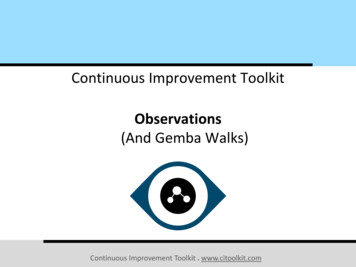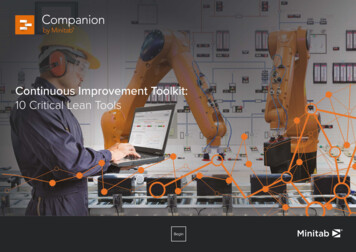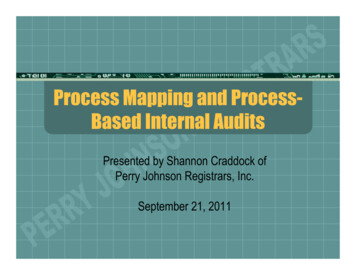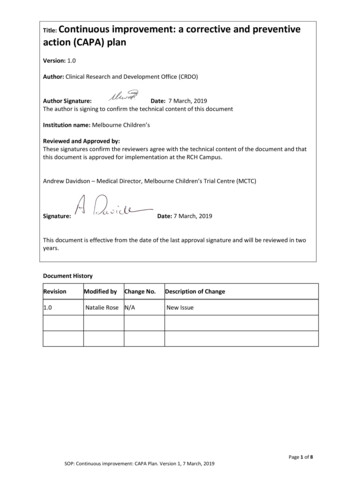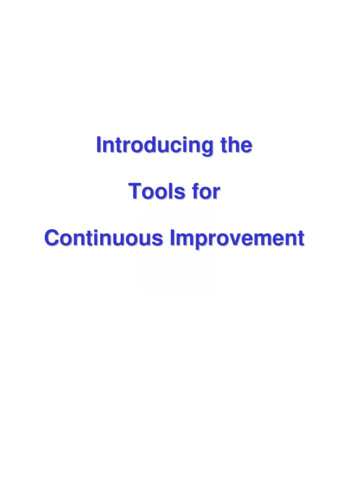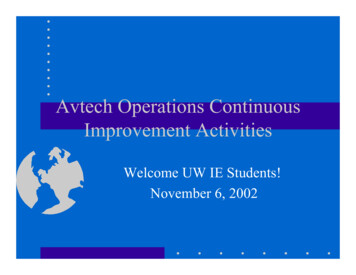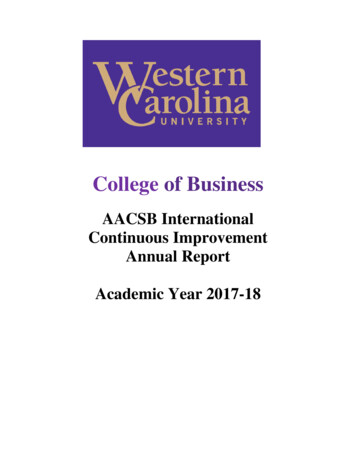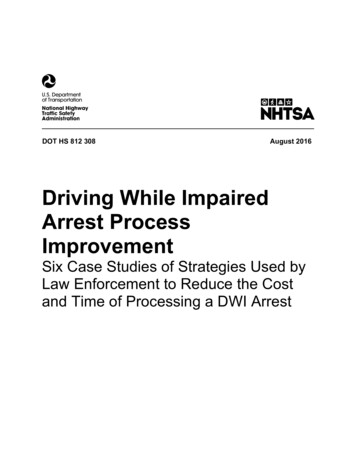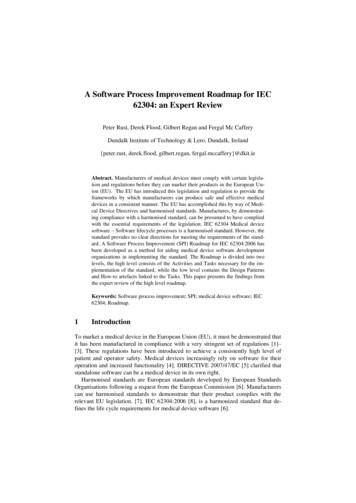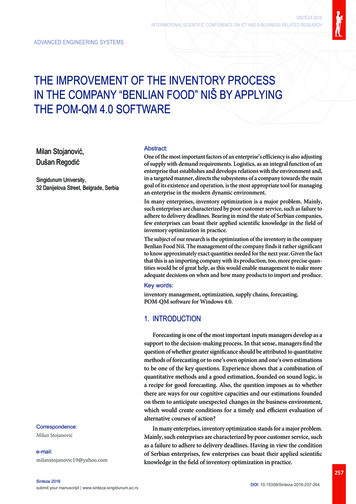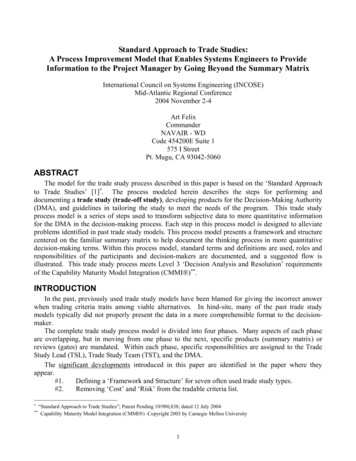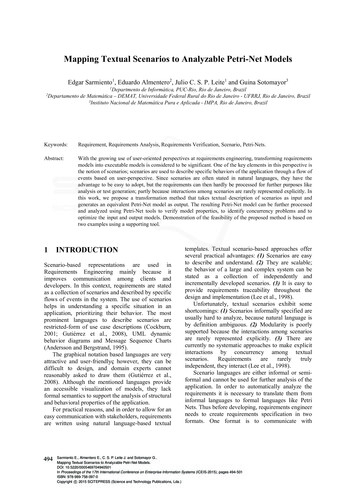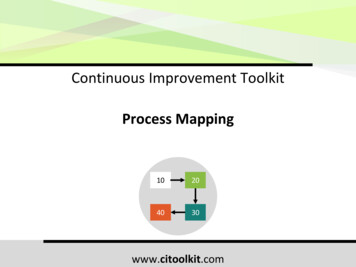
Transcription
Continuous Improvement ToolkitProcess Mapping10204030www.citoolkit.com
The Continuous Improvement MapManagingRiskPDPCFMEASelecting & Decision MakingBreak-even AnalysisPayoff MatrixRisk Analysis*Fault Tree Analysis Decision TreeCritical-to XTraffic Light AssessmentProject arking***HistogramsCheck Sheets**HypothesisScatter PlotsQuestionnairesFocus CAMPER*** Attribute AnalysisAffinity DiagramsMind Mapping*Suggestion SystemsFive WsTPMMorphological AnalysisLateral Thinkingwww.citoolkit.comHealth & SafetyJust in TimeQuick Changeover5SVisual ManagementProduct Family MatrixFlow PullSpaghetti** Process RedesignWaste Analysis**Value Analysis**Value Stream Mapping**Process MappingFlow Process Charts** Time Value Map**FlowchartingGroup CreativityImplementingAutomation Solutions***SimulationSIPOC*Tree Diagram*Control PlanningMistake ProofingData MiningRelations MappingHow-How Diagram***BrainstormingRegressionPolicy Deployment Gantt ChartsBest PracticesMulti-vari StudiesCorrelationImprovement RoadmapsStandard Work Document controlDOEANOVAActivity NetworksStakeholder AnalysisKaizen EventsUnderstandingCause & EffectRoot Cause AnalysisControl Charts Fishbone DiagramsInterviewsPDCAA3 ThinkingChi-Square Nonparametric5 WhysRun ChartsSamplingPortfolio MatrixPaired ComparisonNormal DistributionGraphical MethodsData collection planner*Project CharterPareto Analysis Matrix DiagramKPIsProbability DistributionsBottleneck AnalysisFour Field MatrixPERT/CPMRACI MatrixSWOT AnalysisPrioritization MatrixPugh MatrixDescriptive StatisticsGap Analysis*MOSTTPN AnalysisForce Field AnalysisCost of Quality*Capability IndicesVotingKano Decision Balance SheetLean Measures OEEProcess YieldCost Benefit AnalysisDelphi MethodPick ChartDaily PlanningImportance Urgency MatrixQuality Function DeploymentRAID Log*Planning & Project Management*IDEF0Service BlueprintsDesigning & Analyzing Processes2
A ProcessThe products and services delivered by anyorganization are the result of processeswww.citoolkit.com3
A ProcessAny business activity can be considered as a processManaging these processes is a key to success at anyorganizationwww.citoolkit.com4
A ProcessA business process is a set of steps designed to produce aproduct or service to add value to a customerStarts with a business goal and ends with the achievement of the that goalwww.citoolkit.com5
A ProcessThe outcomes of a well-designed business process are:Increased effectivenessIncreased value for the customerIncreased efficiencyLess cost to the companywww.citoolkit.com6
A ProcessProcess Analysis and DesignWhen analyzing or designing processes, you should consider . . .Maximize customer value as perceived bythe customerAchieve the competitive advantage in termsof quality, responsiveness and low costEliminate steps that do not add valuewww.citoolkit.com7
A ProcessMany defects arise because something in the process is doneincorrectly or inefficientlyTo decrease defects and improve process Sigma Level, weneed to be able to address process problems and find moreeffective ways to accomplish the goal of the process134.66www.citoolkit.com78
A ProcessWe must ensure our processes are increasingly oolkit.comBetterProfitability9
A ProcessProcesses are unpredictable whenpeople do not understand the role ofall factors and their interaction in the businesswww.citoolkit.com10
A ProcessAlmost everything we do at work or home can be brokendown into several process stepsInputs and outputs can then easily be identifiedwww.citoolkit.com11
A ProcessA process is a set of interrelated activities thattogether transform inputs into outputsInputsPROCESSOutputsThese activities are carried out by people, machines, systems, nature, etc.www.citoolkit.com12
A ProcessMAKINGPIZZAPizza ingredientsFlour, tomato sauce,mozzarella cheese,yeast, onion, blackolives, mashrooms,heat sourceWarm Fresh PizzaThe inputs are the things that are transformed by the process into outputswww.citoolkit.com13
A ProcessMAKINGPIZZAPizza ingredientsWarm Fresh PizzaCan be expressed mathematically as Y f(x 1 ,x 2 , x k )www.citoolkit.com14
A ProcessY is a function of X can be expressed using thefollowing formula:Y f(x1, x2, )Output of the processInputs causing variationin the outputsAny Output (Y) is a function of a single or multiple Inputs (X’s)www.citoolkit.com15
A ProcessY f(x1, x2, , xn)To study an existing process, we should identify the key factors X’s thatinfluence the variation of Ywww.citoolkit.com16
A ProcessY f(x1, x2, , xn)In terms of designing a new process, we should fix the specificationsof key X’s to obtain the required Ywww.citoolkit.com17
A ProcessY f(x1, x2, , xn)Lies at the heart of Six Sigma and processimprovementYou can improve Y by identifying and controlling theX’s for any processwww.citoolkit.com18
A ProcessInputs are the variables, the factors, the causes, and thesources of variation which can result in defects and wasteA key concept in Six Sigmais to identify and analyzethese variables.www.citoolkit.com19
A ProcessWhere can you find input sOperatorsand experttechniciansCustomersand supplierswww.citoolkit.com20
A ProcessBrainstorming sessions are often used tocapture these variablesA good first step in is to walk the process.While walking the process, you may takenotes and identify the input and outputvariableswww.citoolkit.com21
A ProcessBy knowing what factors are causing the variation,and by controlling these factors, our systemsbecome more predictablewww.citoolkit.com22
A ProcessConclusionAll processes have the potential for defectsThere is an opportunity to eliminate defects for any processContinuous improvement means regularreview and optimization of key processeswww.citoolkit.com23
A ProcessProduction and Transactional ProcessesProduction ProcessesInvolve the flow of materials inthe production fieldThey include activities such asmachining, assembly andpackagingwww.citoolkit.com24
A ProcessProduction and Transactional ProcessesTransactional ProcessesInvolve the flow of information, humans,objects, tools and money in the servicefield as well as in the transactionalenvironment of the production fieldAre found in:Financial management, procurement,transportation, etc.www.citoolkit.com25
A ProcessAnother Way to Categorize ProcessesManagement processesOrder-fulfilling processesSupporting ProcessesGoverns the operationof the systemCreates the primaryvalue streamSupports the coreprocessesStrategic managementand governancemanufacturing, marketingand salesAccounting, recruitmentand technical supportwww.citoolkit.com26
A ProcessExamples . . .Part of a production process:7080Cutting90Welding100PaintingTestingPart of a transactional process:2030Receive OrderInstall Service4050Invoice CustomerFollow-up Paymentwww.citoolkit.com27
A ProcessSeveral techniques can be used for documenting andanalyzing processesThese techniques will help exposing problems, finding performance gaps,and generating ideas for process improvementwww.citoolkit.com28
A ProcessProcesses can often be visualized with a process mapor a flowchart123www.citoolkit.com429
Process MappingProcess mapping is a graphical representation of theprocessThey are simple ways of making sense of what happens or must happenin a processwww.citoolkit.com30
Process MappingIllustrates the chronological sequence of activities102030605040Represents activities in a step-by-step mannerwww.citoolkit.com31
Process MappingThey allow to know how exactly an organization does itswork, how a process operates, and how well it isperforming in accordance with its objectiveswww.citoolkit.com32
Process MappingCharacteristics of Process MapsThe first step of processmanagementProvides a mechanism for analyzingand studying processesUsed to map existing processes aswell as to design new processeswww.citoolkit.com33
Process MappingHelps identifying the variation and the non-value addingactivitiesEnable the team to agree on the actions that they will take toimprove or redesign the processwww.citoolkit.com34
Process MappingBenefitsBy understanding and controlling the inputs, it is possibleto reduce variation within the processwww.citoolkit.com35
Process MappingOther BenefitsEnhances the understanding of any processand how it operatesBrings clarity to complex processes in order tosimplify, streamline and optimize themIdentifies problem areas and opportunities forprocess improvementwww.citoolkit.com36
Process MappingOther BenefitsHelps identify bottlenecks , delays, duplication ofeffort, and overall inefficient operationsServes as a mean to document and communicatebusiness processesOften found in training, maintenance, technical andquality manualswww.citoolkit.com37
Process MappingOther BenefitsProvides a way of training and orienting newemployeesIdentifies optimal ways to serve customers andshareholdersHelps creating customer-focused processeswww.citoolkit.com38
Process MappingBy analyzing processes, we will be able to:Improve process andproduct qualityReduce cycle time todeliver the product or serviceQualityReduce costcImprove customer satisfactionand livery39
Process MappingThe preparation of a process map is not a solution byitselfIt will however open opportunity to simplify,optimize, streamline, or redesign the processwww.citoolkit.com40
Process MappingProcess CharacterizationTargeting and benchmarking of key process, product,and service characteristics resulting in selecting commonsuccess factors which lead to value creation.Process OptimizationThe measurement and improvement of the processvariables resulting in process improvement.www.citoolkit.com41
Process MappingProcess mapping can provide inputs to othercontinuous improvement techniques such as . . .CAUSE AND EFFECT ANALYSISROOT CAUSE ANALYSISCONTROL PLANSMSAFMEACAPABILITY STUDIESwww.citoolkit.com42
Process MappingThree Process Perspectives1020102030404030What you thinkthe process isWhat the processreally iswww.citoolkit.com102030What the processshould be43
Process MappingThere are different techniques to map a process . . .Simple DrawingSIPOC MapFlowchartOpportunity MapFlow Process ChartProcess ChartValue Stream MapFlow DiagramAll these techniques can provide different views of the processwww.citoolkit.com44
Process MappingThere are different techniques to map a process . . .Simple Drawing Process MapsOnly uses arrows and boxes to represent activitiesNo accessPlan andscheduleinstallationPick uppartsArrive onsiteInstallequipmentand testInvoicecustomerNot in stockwww.citoolkit.com45
Process MappingThere are different techniques to map a process . . .SIPOC MapA high-level summary of the process that lists suppliers,inputs, outputs and tputsCustomers46
Process MappingThere are different techniques to map a process . . .FlowchartProvides a detailed view of the “should-be” process includingdecision points12YesSpe345cNos.www.citoolkit.com47
Process MappingThere are different techniques to map a process . . .Opportunity MapsHelps identifying waste, long delays and other non-valueadded activitiesVAENVANVAStep 1Step 2Step 3www.citoolkit.com48
Process MappingThere are different techniques to map a process . . .Flow Process ChartProvides a way to identify the non-value adding steps includingthe time taken and the distance traveled per stepTakesamplesTo QCstationInspectsamplesEnter resultsWait reportinto spreadsheet to be printedwww.citoolkit.com49
Process MappingThere are different techniques to map a process . . .Process ChartAllows to provide further information about each process stepincluding time and distanceStepTimeDistance#IN MINSIN METERSProcess descriptionwww.citoolkit.com50
Process MappingThere are different techniques to map a process . . .Value Stream MapUsed to prioritize improvement opportunities by helpingidentify bottlenecks, delays and wasteProductionControlSupplierCustomerDaily toolkit.comFIFOShipping51
Process MappingThere are different techniques to map a process . . .Flow DiagramDepicts patterns of movement of product, materials, toolsinformation and peoplewww.citoolkit.com52
Process MappingSo which process mapping technique is best?www.citoolkit.com53
Process MappingIt depends on what you want to achieveSimply presenting the activitiesUnderstanding layout issuesExpanded look at where value is addedShow the high-level of the processwww.citoolkit.comS IP O C54
Process MappingFrom this point until the end of the material, we willuse the simple drawing process maps toillustrate the exampleswww.citoolkit.com55
Process MappingSimple drawing is the most basic form of process mapswhich uses only boxes and arrowsBoxes to indicate the activitiesArrows to indicatethe flow directionAdditional information can be added to each activity (time, responsibility, )www.citoolkit.com56
Process MappingExample – Doing the aundrywww.citoolkit.com57
Process MappingJust like real maps, process maps can be created fordifferent levels in the organizationEach process step can itself be decomposed into several sub-stepswww.citoolkit.com58
Process MappingEvery business process can be described atdifferent levels of detailAt the strategic level, they often show thecore processes only and would not havemuch detailsIn order to understand a process step insufficient detail, you need the detailed viewof that specific proces
www.citoolkit.com57. Process Mapping. Example–Doing the Laundry. 30 Select settings 10 Sort laundry 40 Add detergent 20 Load washer 60 Unload washer 80 Select settings 50 Start washer 70 Load dryer 90 Start dryer 110 Fold laundry 100 Unload dryer.
